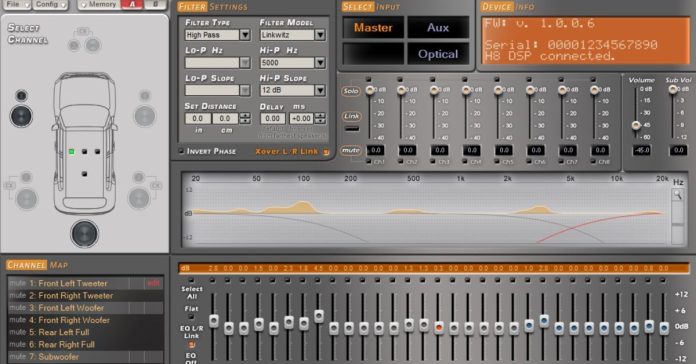When it comes to upgrading your car’s audio system, most people think about swapping out the stereo or adding better speakers. But if you’re a true audiophile, you’ve probably heard of a Digital Signal Processor (DSP) and how it can take your car’s sound system to the next level. If you’ve ever wondered whether a DSP is worth the investment, this guide will explain what it does and why you might need one for your vehicle.
What is a DSP?
A Digital Signal Processor (DSP) is a device that allows you to control and fine-tune the audio signals in your car, offering more precision than what most aftermarket stereos provide. It works by processing the sound signals before they reach your speakers, adjusting things like frequency, time alignment, and equalization to ensure the sound is optimized for your car’s unique acoustics.
While your stereo might come with basic sound controls like bass, treble, and mid-range adjustments, a DSP lets you dive much deeper into the audio settings. It’s like having a mini sound studio right inside your car, allowing you to customize the sound exactly to your liking.
Do You Need a DSP for Your Car?
Not every car audio system needs a DSP, but if you’re someone who cares about sound quality, it can make a huge difference. Here are a few reasons why you might want to consider adding a DSP to your car:
- Perfect Sound Customization: Every car is different, and the placement of your speakers, the shape of your interior, and even the materials used in your car’s cabin can affect the way sound travels. A DSP allows you to adjust the sound for your specific car, giving you a richer, more immersive audio experience.
- Better Speaker Integration: If you’re upgrading your speakers or adding an aftermarket subwoofer, a DSP can help integrate these components more effectively. You can adjust the crossover points, balance the sound, and ensure that each speaker is working in harmony with the others.
- Improved Soundstage and Imaging: If you’ve ever been to a concert, you know how amazing it is when the sound feels like it’s surrounding you. A DSP can recreate that feeling in your car by adjusting the time alignment of your speakers, so the sound reaches your ears at the same time from all angles. This creates a more immersive soundstage, making it feel like the music is coming from all around you rather than just from the speakers.
- Fine-Tuned Frequency Control: Most car stereos come with basic EQ settings, but a DSP lets you fine-tune each frequency band in much more detail. This means you can balance the bass, mids, and highs to perfection, no matter what kind of music you’re listening to.
When is a DSP Not Necessary?
While a DSP offers plenty of benefits, it’s not necessary for everyone. If you’re just looking for a simple stereo upgrade and aren’t too concerned with the finer details of sound quality, your aftermarket head unit might already have enough EQ controls to satisfy your needs.
Additionally, if you’re not planning on upgrading your speakers or subwoofers, or if you primarily listen to music casually through Bluetooth, you might not notice as big of a difference with a DSP.
How to Install a DSP in Your Car
Installing a DSP in your car is a bit more involved than a standard stereo upgrade, but it’s not overly complicated if you have the right tools. Here’s a basic overview of how the installation process works:
- Choose the Right DSP for Your System: Make sure you select a DSP that’s compatible with your stereo and speakers. You can find vehicle-specific Autoradio Einbauset to make the process easier.
- Connect the DSP to the Stereo and Speakers: The DSP is installed between your head unit and the speakers. It processes the audio signals before sending them to the speakers, allowing you to fine-tune the sound.
- Calibrate the DSP: This is where the magic happens. After installing the DSP, you’ll need to calibrate it using software. Many DSPs come with a companion app or computer program that allows you to adjust the sound settings in detail.
- Test the System: Once everything is connected and calibrated, test the audio system to make sure the sound is balanced and customized to your liking.
Should You Get a DSP with a New Stereo?
When upgrading your car’s stereo, you might wonder if the DSP is built into the new head unit. Some high-end stereos do come with basic DSP features, such as a built-in equalizer and basic sound controls. However, for truly customized sound quality, an external DSP offers much more flexibility and control.
If you’re serious about getting the best possible sound in your car, investing in a dedicated DSP is the way to go. You can find both single-DIN and double-DIN stereos, as well as Autoradio Adapter to connect everything properly during installation.
Conclusion
A Digital Signal Processor (DSP) is a powerful tool that can transform your car’s sound system, offering much greater control over how your music sounds. Whether you’re looking to create the perfect soundstage, fine-tune your bass, or integrate new speakers into your system, a DSP gives you the flexibility to get it just right.
While it may not be necessary for casual listeners, audiophiles and anyone serious about getting the best possible audio experience will find that a DSP is well worth the investment. If you’re planning to upgrade your car’s sound system, make sure to consider whether adding a DSP will help you achieve the level of sound quality you’re after.




